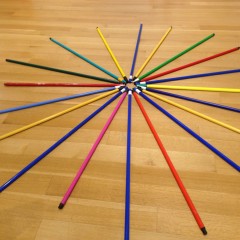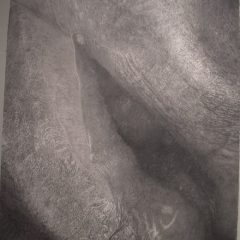Jeff Ross lived in Seattle for two decades (1989 – 2009) and had a small art company that designed posters and t-shirts for record companies Sub Pop and C/Z Records, for hundreds of rock groups, including Nirvana, Mudhoney, Afghan Whigs, The Fluid, Reverend Horton Heat. After he closed his business in 2009, Ross, now 56, moved to Bangkok to work on his own paintings, and his collages and silkscreen prints, which he produces on paper material, usually, advertising posters he’s stripped from walls all over the world. Ross will take posters, photograph them close up, and use parts for silkscreen images which he will reorganized to produce pop-like works that can often skirt description. Then the paper will be turned into large collage compositions that are mostly abstract, much like the nouveau realistes produced in the early 1960s. Ross is largely self-taught with a talent for graphic design.
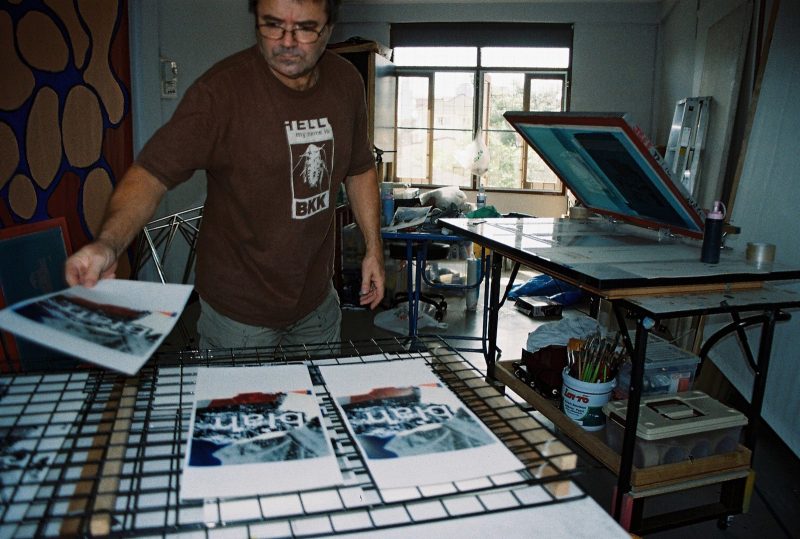
I’ve known Ross since 2008 when he emailed me after seeing post cards from my Spelling with Scissors show I’d left in my Berlin Gallery. We’ve been in touch ever since, and when he was in Paris last month, hunting up shows and collage material, he dropped into my studio for a visit.
After describing how he scouts out locations for weathered street posters to tear off walls in various cities, Jeff, revealed his obsession with — and collecting of — the works of “Outsider” or “self-taught” artists.
Artists like Judith Scott, Minnie Evans and Howard Finster among others, make works that are best described as “naive” but often referred to as “art brut” – raw art. These artists take the human experience to new places, and often riff on Christ, UFOs, and the all-knowing government. The compulsive detailing of their visions could be paranoid, joyful or surreal, but the common denominator is that the artists are untrained.
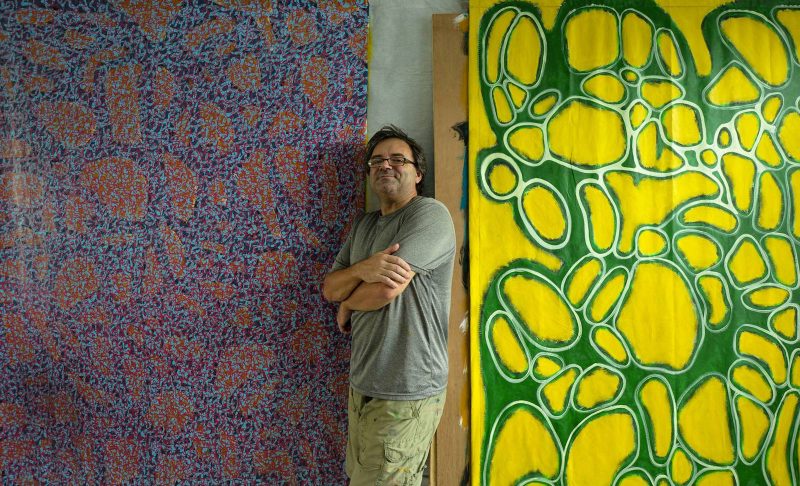
Ross began actively buying outsider art in the early 1990s, and his collection of drawings and objects now numbers in the hundreds; many pieces are by some of the best known artists in the outsider world. Below is a glimpse at our conversation.
Matthew Rose: Walking through the Montparnasse Cemetery, you described your fascination with outsider art. You’ve collected works by Minnie Evans, Tubby Brown, Judith Scott…What was it that first drew you to these artists? Is it the way they’ve worked, their visions, their obsessions?
Jeff Ross: A friend of mine had some Howard Finster works, which I liked very much. The simplicity of these pieces just clicked for me. Then, one year during the Jazz Fest in New Orleans (1996 – 1997), I suggested to my friend we rent a car and drive to Georgia to Howard Finster’s house – what Finster calls “Paradise Garden.” Along the way, we met R. A. Miller, Tubby Brown, and Roy Finster. Seeing Paradise Garden in person was a visual overload. The adventure in the world of outsider artists began with my traveling and accelerated with my collecting.
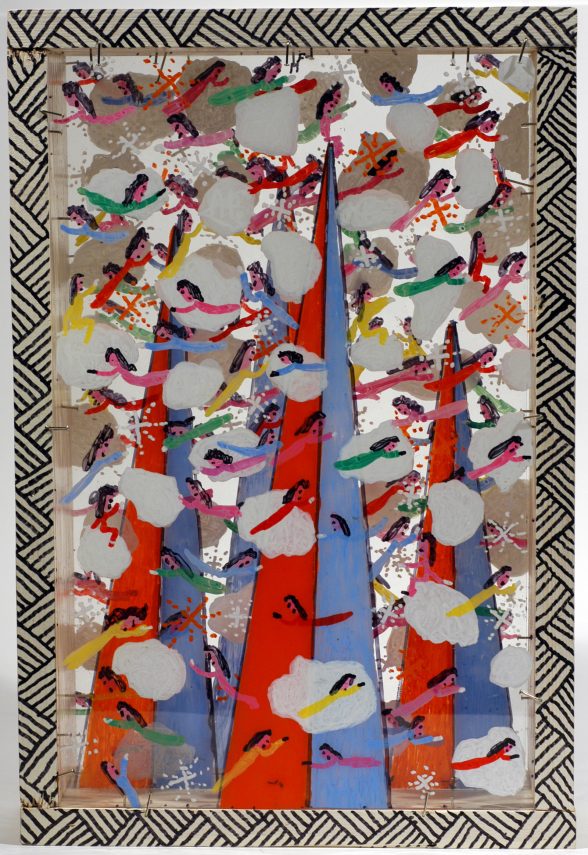
Matthew Rose: As an artist yourself, something rang true to you seeing all this art?
Jeff Ross: Being a screen printer, the amount of work these artists made hit the sweet spot. I saw thousands of ideas in this work, and it resonated with my own work, and it still does. The obsessive creating makes sense to me.
I consider myself a creator more than an artist. I create with whatever is at hand — usually the torn posters I recuperate from walls in various cities in Asia and Europe. It’s the same with the art I collected. Most of it is made with whatever is around – found, accessible materials. These outsider artists didn’t worry about perfect art supplies. Just the drive to create.
Matthew Rose: Did you buy a work when you were at Paradise Garden? And the artists you met on that year during Jazz Fest, did you also buy works from them?
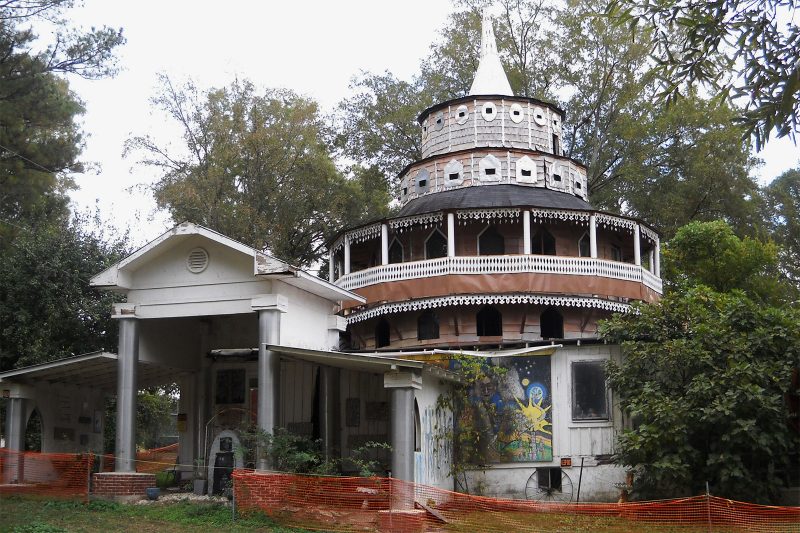
Jeff Ross: When I went to Paradise Garden it was around 1996. Howard Finster wasn’t there. So I spent the afternoon with his son Roy and was able to buy work from Howard, and Roy as well and even Michael, Roy’s son.
Wandering around the grounds of Paradise Garden, I experienced complete visual overload. I was a kid in a candy store taking photos of Finster’s incredible park. It was clear, though, that things had already began to disappear by then in 1996 or 1997. Works were being sold off, but at least I was lucky enough to see most of it intact.
In the end, sadly, I never did get to meet Howard. [Ed note: Howard Finster died in 2001.]
At Jazz Fest though, I met Big Al Taplet. Big Al Taplet was a shoe repairman. He made signs made from roof tiles that he hung in a tree nearby where he worked. I bought his self-portrait from his first gallery show. And also a six foot self-portrait he made for Jazz Fest.
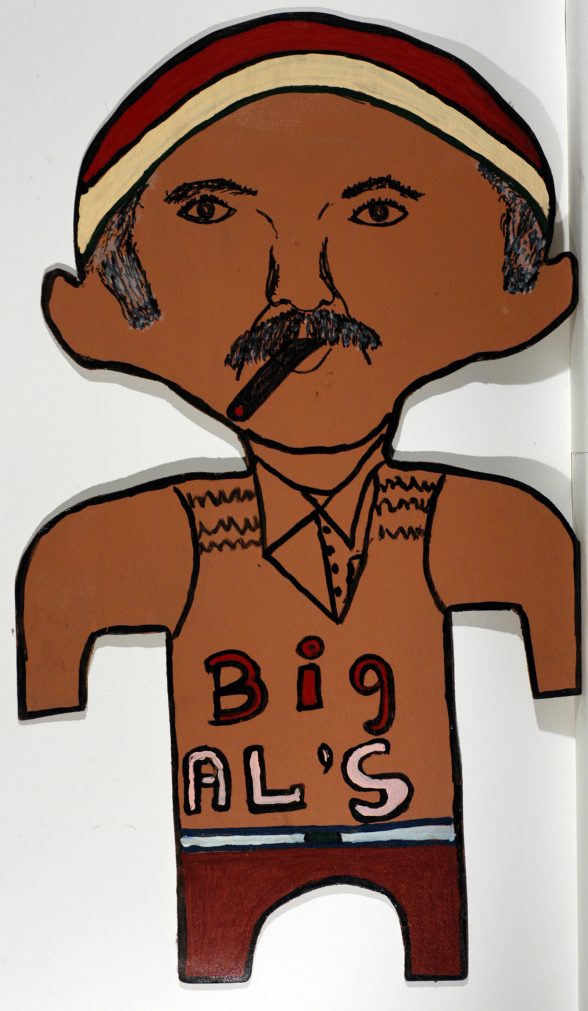
Matthew Rose: You mentioned that you’d seen James Castle’s work some years ago but then you were focused more on another outsider artist’s work at the time, Minnie Evans (1892-1987). I have seen Castle’s works in Paris and found myself absolutely smitten with Castle’s world. The drawings are beautiful and heart breaking, so intimate you can almost see him producing these on his family’s farm table in Idaho. What was it about Castle’s work that didn’t at first catch your eye?
Jeff Ross: I was at the Outsider Art Fair in New York City around 1996 or 1997, to see and eventually acquire some of Minnie Evans drawings. That is where I probably first saw James Castle’s work; perhaps it was the first time Castle’s work was exhibited in public, and I believe the J Crist Gallery from Boise, Idaho, showed the work. If I remember, they sold out the Castles — small assemblages and collages — at about $500 each. While I missed the Castle boat, I did pick up a number of Minnie Evans pieces from the Louise Ross Gallery (no relation).
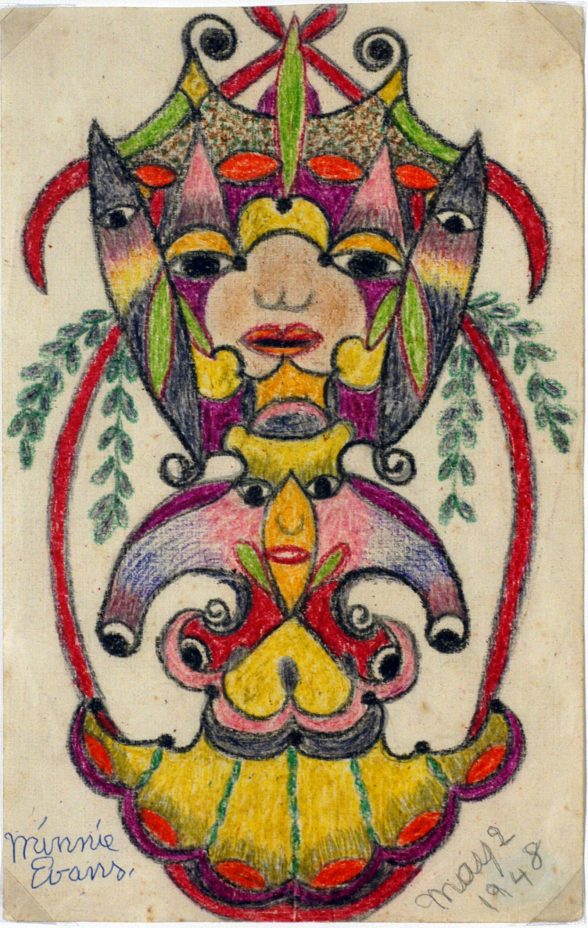
Matthew Rose: Tell me about Judith Scott. She was an early find for you. The artist had Down syndrome, severe deafness and was institutionalized for more about 35 years. Yet she created fascinating artworks: found objects wrapped fastidiously in wool and thread. These are mystical pieces, some large some small, koans of spiritual quality with a rawness and mystery. Scott is now one of the most exhibited of the outsider artists and I imagine her works, so rare, are very expensive.
Jeff Ross: On one of my early art journey-hunts, I went to the Creative Growth Center in Oakland, California to see some Dwight McIntosh drawings. At the time he was the superstar working there. I made an appointment and flew from Seattle. While there I was given a tour of the other artists and their work. A fascinating environment! I purchased two Dwight McIntosh drawings and planned to return.
On my second trip I was shown some of Judith Scott’s work. Scott (1943 – 2005) makes these woven sculptures that are bright and mysterious. They are wrapped and tied, and inside are objects she’s found and hidden. I picked one up and couldn’t put it down. I carried it everywhere throughout the Center that day. Needless to say, I bought it and took it home. But for some reason that day, I kept my buying ways in check. I told myself that I will only get one. My usual modus operandi was to buy every piece I could and all at once.
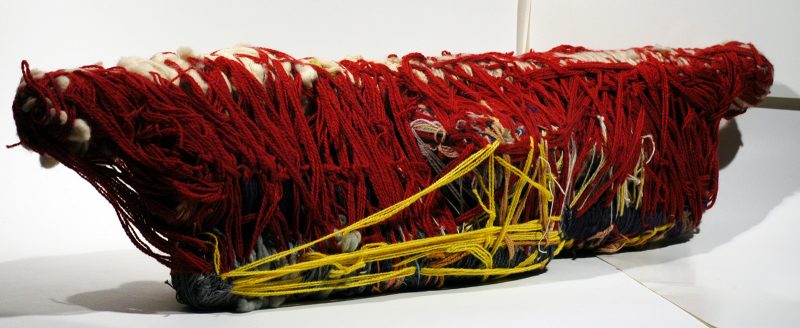
Matthew Rose: What happened next?
Jeff Ross: After I returned to Seattle, I just couldn’t stop thinking about Scott’s work. So I called the Center back, and they told me that they had put a hold on sales of Judith’s work because they were trying to get a grant to make a book about her. And at the same time, there was a very powerful gallery in New York City looking to have an exclusive on selling her work.
I was persistent, though and did get back to the Center in 1997 or so, and I picked out eight more pieces I wanted but was told I could only buy two smaller works, and only one of the larger pieces. Some time later, I went to New York and saw the large piece that I didn’t buy – it was for sale for a crazy amount of money – upwards of 7,000 in the early 2000s. The first small work I bought of hers was $40! The larger piece was $150. This was before Metamorphosis, the 1999 book that came out on her life and her work. I have no idea what they go for now.

Matthew Rose: Your collecting started a few decades ago … but now you’ve stopped. What happened and what are you planning from your studio in Thailand?
Jeff Ross: After close to 20 years of collecting, I closed my screen printing business. The extra money flow stopped, and I had to go cold turkey on any more collecting. If I could though, I would love a collage work by Jacque Jacques Villeglé, an art brut work by Jean Dubuffet, and an abstract by Serge Poliakoff. But their prices are way too high for me!
Some years ago, I simply decided to pursue my own art full time. As the typical folk artist story goes, I had a very bad accident, almost losing my foot. I couldn’t work at all and could barely walk for over a year. But I kept on creating as best as I could. After five years of hobbling with a cane, my ankle has finally healed so I can walk pretty close to normal. Now I can print, paint, collage and travel. I’m planning an exhibition for Paris at the end of 2017.




